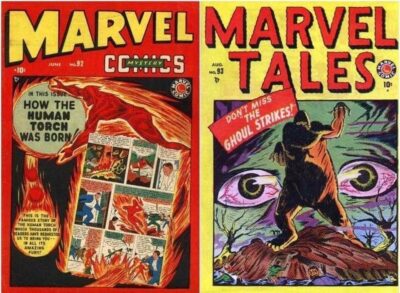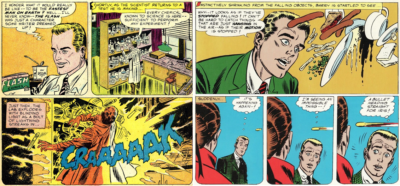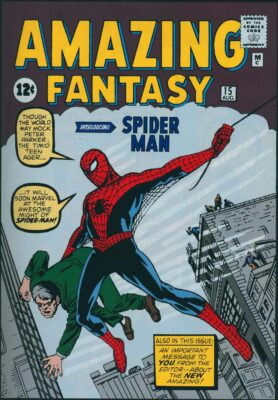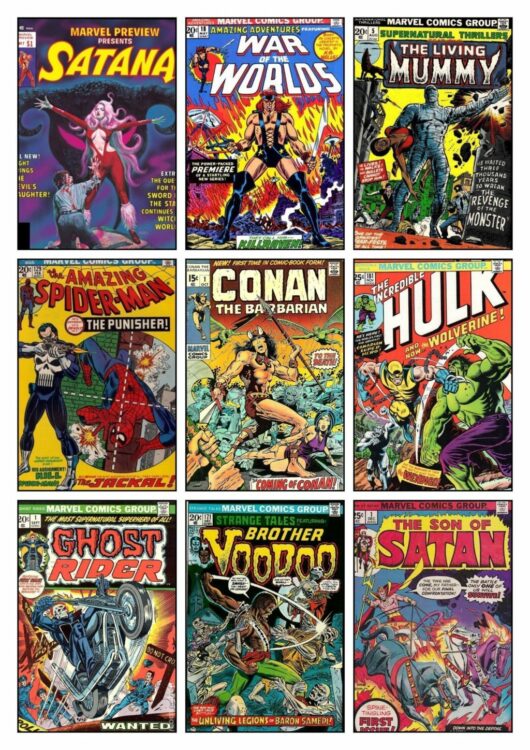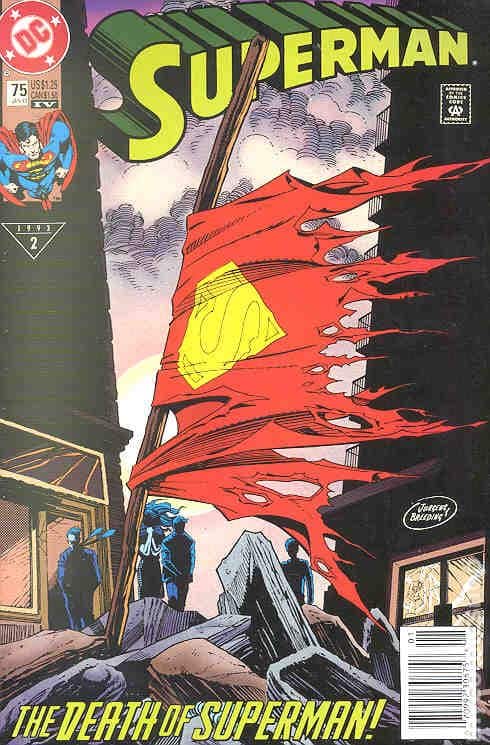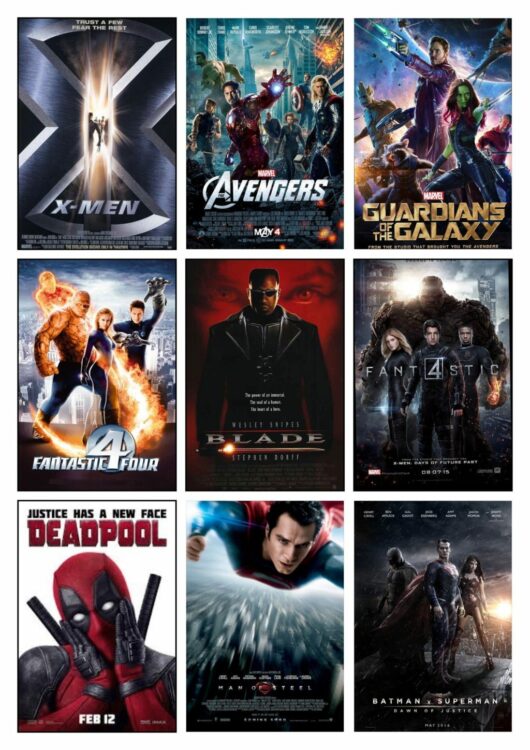The 8 Ages of Comic Books by Alex Grand
Read Alex Grand’s Understanding Superhero Comic Books published by McFarland Books in 2023 with Foreword by Jim Steranko with editorial reviews by comic book professionals, Jim Shooter, Tom Palmer, Tom DeFalco, Danny Fingeroth, Alex Segura, Carl Potts, Guy Dorian Sr. and more.
In the meantime enjoy the show:
Welcome to CBH, today we’re talking about the 8 ages of comic books including the:
Platinum Age (1897-1937), Golden Age (1938-1947), Atomic Age (1948-1955), Silver Age (1956-1969), Bronze Age (1970-1984), Dark or Copper Age (1985-1991), Extreme Age (1992-1998), Movie Age (1998 – 2016)
Read below and/or click to watch the video:
How does defining these ages help us? I think it creates some sort of structure or framework within which we can talk about other comic book events or people. How do we define an age? These ages really tend to focus on the presence or absence of superheroes, and if present, then what flavor of superhero the mainstream is paying a lot of money to see more of. What are the cons of focusing too much on ages? They don’t address comic newspaper strips, romance comics, international comics, independent comics, underground comics, and other genres. As far as comic book history, comic books have been around for a very long time. In 1682, British painter, Francis Barlow painted A True Narrative of the Horrid Hellish Popish Plot about a historical event utilizing caption boxes, dialogue balloons and panels.

In 1842, we have the first recorded graphic novel in America with sequential art called “The Adventures of Obadiah Oldbuck.”
Theoretically sequential art goes back to the ancient Egyptians, but for the sake of simplicity it’s good to start somewhere. Pre-1897 would be a proto age of international and victorian sequential imagery, but in 1897, we have our first real comic book called “The Yellow Kid” which is a reprint of the Yellow Kid newspaper strip. Something special here is that it actually says its a comic book on the back, so this is thought to start off the pre-Superhero Platinum Age.
There are many more examples of platinum age comic books like this 1911 reprint of the Mutt and Jeff newspaper strip.
Fast forward even more comic books to 1937, we have Detective Comics 1 which is comprised of comic short stories with content based on old pulp magazines.
This 40 year period from 1897-1937 is marked by different attempts to reprint newspaper strips with expensive licenses or create new pulp inspired comics at cheaper rates from new young artists and writers. There were many attempts to make a profit during this time, with many failures and success.
Ultimately there was 40 years of comics before the Comic Book that heralded the Golden Age (1938-1947) which was Action comics 1, 1938, the first appearance of Superman.
This comic, had elements of John Carter’s jumping on Mars, physical superiority in the vein of Bernarr MacFadden’s Physical Culture magazine,
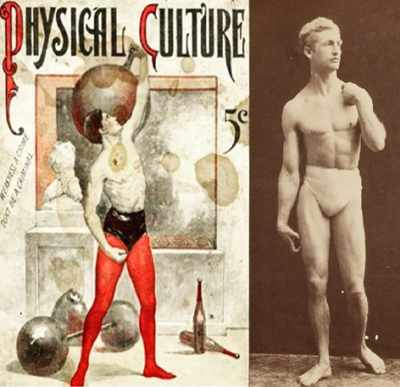
caped heroism of Douglas Fairbank’s Zorro and Crime solving like 1880’s Nicholas Carter,

with tight circus clothing,

the Superman characteristics present in previous characters like Doc Savage and Popeye,

and characteristics similar to Philip Wylie’s Gladiator.
 Kal-El’s baby ship even resembled this ship on the cover of Hugo Gernsback’s 1935 Amazing Stories.
Kal-El’s baby ship even resembled this ship on the cover of Hugo Gernsback’s 1935 Amazing Stories.

Superman carried with himself a mission to defend the week and this type of heroism was so successful it heralded many other me-too characters like Batman in Detective comics 27, 1939,
and the first appearance of Wonder Woman in All Star comics 8, 1941
as well as Captain America Comics 1, 1941.
Pre-WW2 Heroes in the late 1930s were still very much in the vein of depression era pulp vengeance. Look at Superman, Batman and Namor in the late 1938-1941 acting more like vengeful anti-heroes.
My friend Ken Quattro found this editorial edict from Whitney Ellsworth to the editors in DC Comics to make their comics more family friendly in 1941 changing the course of these characters.
What a large difference patriotism in WW2 and an editorial edict makes to the presentation of Superheroes to the comic book industry! The material essentially became far more wholesome.

These are only a few examples in an explosion of Golden Age Superheroes that would do well in these World War 2 years until the late 1940s when soldier’s would come home, get married,
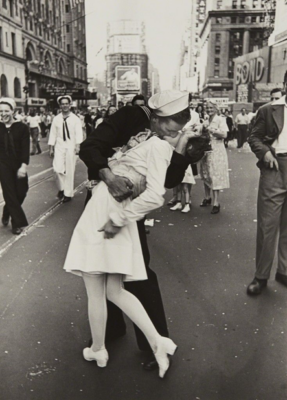
get their old jobs back or use the GI bill to advance their vocations. Their interests would vary from the previous fantastic superhero to other genre’s like westerns.
After WW2, Superhero comics would start to trickle out of the mainstream and their books would mostly transition to non superhero genres. In 1948, All American comics 102, 1948 would phase Green Lantern out of the top left corner and rename the title into All American Western 103.
The same thing happened to the Human Torch, who was famously on the cover of Marvel Comics 1. He would get phased out of his comic by issue 93 with a complete renaming of the comic book in 1949.
Although Batman and Superman would continue to exist through this time, Captain America did not fare so well. His book was renamed into Captain America’s Weird Tales and was completely phased out of the comic in the same year as the human torch and replaced with horror genre material.
By 1951 most Superhero books were discontinued for other genres, and this brief hiatus of the mainstream from Superheroes is currently called the Atomic or Television Age (1948-1955).This is likely because many people were reading comics that mimicked tv show genre’s since everyone bought a television in the early 1950s.

Romance, Crime, Western’s, Suspense, Science Fiction, War, Satire and even Horror became the preferred genre’s in Comic Books in the early 1950s.
Ultimately Crime and Horror sold great, but the gruesome covers would begin to disturb mother’s of children buying this for a dime at their local newsstand and ultimately politicians and child psychologists would get involved.
Roughly around 1950, Horror comics became very popular, and the most successful publisher producing those books was EC Comics’ Bill Gaines. These stories visually depicted beheadings of women, murders, and other crimes so eventually there was some pushback from more restrained groups in America especially politically liberal and concerned doctor’s like Fredric Wertham who felt these books were encouraging juvenile delinquency. Whether those claims were true or not, the accusations were enough to bring some congressional oversight led by Democratic Senator Estes Kefauver which led comic companies to regulate themselves with the comics code authority. The comics code authority set up a series of rules that narrowed down the type of creativity that could be used in comic books. There was a period of stagnation where publishers were trying to figure out what to safely publish and still make a good living. Bill Gaines couldn’t produce good Horror comics under the code so discontinued EC Comics and continued Mad comics as a magazine.
Over at DC Comics, the slick New York line dominated at the newsstand with Superman’s Pal Jimmy Olsen as they were more prepared for the oncoming kid friendly comic books that would be required at newsstands to sell with the comics code label on the top right. Martian Manhunter would premiere in Detective Comics 225, 1955 as science fiction alien hero that got several elements from Ray Bradbury’s Martian Chroniclesl However it was Carmine Infantino, Julius Schwartz, and Robert Kanigher who applied their talents to uncover the formula that would do the best during the new era of the comics code in Showcase 4, 1956 which introduced the modern Barry Allen Flash and started off the Silver Age (1956-1969).
This story written by Robert Kanigher about an average guy gaining superpowers under a bizarre science fiction event would be the template for a lot of character creation for the next 14 years. An everyday man, hit by a bizarre science fiction event, discovers his new powers and the world around him in a vein of optimistic humanism. Wonder Woman artist would change from Harry Peter in issue 98, 1958 to Ross Andru and Mike Esposito.

In 1959, Gil Kane and John Broome created Hal Jordan Green Lantern for Showcase 22, again about another guy who gained a super powered ring under a bizarre science fiction event. This new Green Lantern had elements of the old pulp story, The Grey Lensmen.
Aquaman’s origin changed during the same year 1959 to fit this new generation of readers to include that he was the son of an Atlantean princess and the lighthouse keeper storyline in Adventure Comics 260 by Bernstein and Fradon. Originally in More Fun 73, 1941 he was taught by his scientist father who to breathe underwater. These retcon’s to the silver age were part of the main ingredients of the period.

The groundwork for the DC Silver Age was roughly established in the later 1950s, but many events came together in 1960 to accelerate the coming changes.
Rawhide Kid 17 was Jack Kirby and Stan Lee’s first collaboration on an ongoing character, Cassius Clay would win the Olympics in boxing, the first issue of Justice League of America debuted, JFK was elected president, and the Beatles formed their group.
In 1961, the age of the astronaut would officially begin. Alan Shephard flew above the atmosphere and back down establishing the USA’s first step into space. John Glenn was the first American to orbit earth in 1962, and Neil Armstrong would step on the moon in 1969. These men were heroes of their time and helped identify the Silver Age as optimistic about the frontier or future through science. Around the time of the 1961 mission, it is also said that Jack Liebowitz from DC was playing golf with Martin Goodman of Timely/Atlas and soon to be Marvel Comics. Jack mentioned that his Justice League comic in 1960 which united the 5 new silver age DC characters indicated that Superheroes were having a comeback.

Martin Goodman is thought to have asked Stan Lee to come up with a similar team, with which he co-created four astronauts that became a superhero team through a bizarre science fiction event in Fantastic Four 1 by Jack Kirby and Stan Lee.
Marvel would create other characters such as Spider-Man by Steve Ditko and Stan Lee in Amazing Fantasy 15, 1962.
By the time it was 1969, both DC and Marvel had created a whole mythology of heroes who gained their powers and stories through bizarre science fiction events.
There was a period of social relevance that started in 1970. The civil rights era brought about an awakening in many writers and artists of the time and Green Lantern Green Arrow 76 by Neal Adams and Denny O’neil premiered, the first Friday Foster Strip about an African-American female was introduced, The Kent State Massacre had occurred, Mort Weisinger left DC comics as Editor of the Superman line of comics with Superman 231, Jack Kirby left Marvel for DC to introduce New Gods in Jimmy Olsen 133, Janis Joplin and Jimmie Hendrix died, Paul announces the Beatles break up, America was worn down by the unsuccessful Vietnam War, NASA lost its funding for furthering space travel, and Conan 1 by Roy Thomas and Barry Windsor-Smith starts as the Comics Code Authority loosens its grip.
At this point the Silver Age innocence was lost and the hardened realities of the Bronze Age begins. I have reason to agree that Conan 1 started off the Bronze Age in 1970. The Silver Age was characterized by a burst of new superhero creation. However the Bronze Age appears to be a similar movement with the industry creating more pulp-era vengeful anti-heroes. Conan is a hyborian Tarzan, an animalistic survivor in a kill or be killed type of world. This hero was very unlike his predecessors from the 1960s. Conan premiered during a time when there were a lot of tragedies and disappointments happening, and people welcomed this violent antihero with open arms. This comic was critically acclaimed and successful which led to many more violent antiheroes for example the Punisher, a Dirty Harry type character who developed a large following.
There was also Wolverine in Hulk 181 who carried a similar theme of being a good guy type of killer who got the job done.
Both Punisher and Wolverine came out in 1974, With that, there were many anti-heroes that burst onto the scene during the 1970s defining the Bronze Age.
The Bronze Age continued until 1985 when we have the birth of the Copper or Dark age.
This age was more ambiguous, but there were certain industry triggers like the growth of the direct market with competing independing publishers, which did not require comics code authority approval to produce dark, psychologically complex stories. The Big 2 companies, DC and Marvel were likely nudged by this trend to break their superheroes that came before into something new, dark, and psychologically complex for the latter 1980s.
1985 Crisis of Infinite Earths by Marv Wolfman and George Perez essentially accomplished this, continuing into Dark Graphic novels like the Dark Knight Returns by Frank Miller
and the Watchmen by Alan Moore and Dave Gibbons.
This was also an age of self involvement when heroes were being hero’s to make themselves feel good, or enjoy it in a dysfunctional way. This may be some critique of how deregulation in the early 1980s led to a self involved journey to make money and the potential greed that some writer-artists perceive of the era.

Lobo was an anti-hero and villain depending on the story, but ultimately tortured who he felt like torturing, Hank Pym of the Avengers beat up his wife the Wasp during a psychotic break, and Alan Moore commented on the Superhero Genre with the Watchmen illustrating the self involvement of superheroes in general.

Marvel also had their fair share of Dark, psychologically complex stories like the Morlock Massacre, Scourge murdering villains, and the Punisher being a hero compared to dirtbags like Nuke or Sabretooth.
Even Superman was not immune to this sort of self-involved change in 1988 when John Byrne wrote for him to kill evil Kryptonians with a leadbox of Kryptonite to save other planets from more of their genocide. 
The Dark Age continued until late 1991 when comics would go EXTREME!!!
The 1990s had blockbuster success with the advance in Action films starring muscular figures like Schwarzenegger, Van Damme and Lundgren. The muscles on both the men and women, wearing tights, packing shoulder pads, guns, and ammo ultimately sold well in theatres and made their way into the comic books.
There were many comics in the late 80s and early 90s which would trickle into this Extreme Age, but for over simplification sake I would say the issue that heralded this type of comic and defined the new trend was X-Force 1 by Rob Liefeld. Shortly after X-Force 1, he would go on to make Youngblood 1 when he and other artists would leave Marvel comics to start Image Comics.
DC Comics also started the Death of Superman story arc that went on for a few years.
This Extreme Age would continue til 1998 and would define itself by the need to feed into Extreme over the top aesthetics, stylistic sensational multiissue crossover storylines which maxed out consumption as much as possible where plot or even basic anatomy didn’t matter as much as the visual gimmicks, die cut hologram covers, and swimsuit specials that were used to sell to a collectors market that busted up pretty bad. Eventually people got tired of this type of comic book storytelling and it just sort of went away.
In 1998, a movie came out named Blade which was the first successful Marvel attempt and making a movie,
which led to later films like X-Men
and all of sudden we have a whole slew of successful comic book movies. What makes this an age for comic books is that the success of the movies then change the content of the comic books to match for corporate synergy. The odd thing here is the comic books were the source material for the movies which is becoming source material for the comics which to some feel a recycled undertaking. At our current point the comics we see, whether we like it or not, are filtered or reflected off the success of the comic book movies.
This ends my introduction to the comic book ages. Remember, these are generalizations since there are a lot of comics made during these ages that have nothing to do with superheroes or movies, etc, but once we define the Golden and Silver Ages by flavor of specific Superheroes, then that starts to define the other ages. How does defining these ages help us? I think it creates some sort of structure or framework within which we can talk about other comic book events or people in future episodes of CBH. Stay tuned and we’ll talk to you later.
Join us for more discussion at our Facebook group
check out our CBH documentary videos on our CBH Youtube Channel
get some historic comic book shirts, pillows, etc at CBH Merchandise
check out our CBH Podcast available on Apple Podcasts, Google PlayerFM and Stitcher.
Use of images are not intended to infringe on copyright, but merely used for academic purpose.
Mickey Mouse ©Disney, Detective Comics ©DC, New Fun Comics ©DC, Action Comics © DC, All-Star Comics ©DC, All-American Comics © DC, Flash Comics © DC, Marvel Comics ©Marvel, Captain America Comics ©Marvel, All-American Comics ©DC, Marvel Tales ©Marvel, Weird Tales ©Marvel, Sub-Mariner Comics©Marvel, All Star Comics ©DC, Crime SuspenStories ©Gaines, Showcase Comics©DC, Rawhide Kid ©Marvel, Justice League America ©DC, Green Lantern ©DC, Fantastic Four ©Marvel, Amazing Fantasy ©Marvel, Hulk ©Marvel, Tales of Suspense ©Marvel, Youngblood ©Liefeld, Spawn ©McFarlane, WildCATS ©DC, X-Force ©Marvel, Journey Into Mystery ©Marvel, Strange Adventures ©DC, Green Lantern Green Arrow ©DC, Supermans Pal Jimmy Olsen ©DC, Superman ©DC, Conan ©CPI, Amazing Spider-Man ©Marvel, Marvel Preview Presents ©Marvel, Ghoster Rider ©Marvel, Strange Tales ©Marvel, The Son of Satan ©Marvel, Crisis on Infinite Earths ©DC, Batman ©DC, Watchmen ©DC, The Mighty Thor ©Marvel, The Punisher ©Marvel, The Uncanny X-Men ©Marvel, Captain America ©Marvel, Daredevil ©Marvel, X-Factor ©Marvel, Movies: Blade ©New Line, X-Men ©20th Century Fox, Avengers ©Marvel , Guardians of the Galaxy ©Marvel Entertainment, Fantastic Four ©twentieth Century Fox, Deadpool ©twentieth Century Fox, Man of Steel © Warner Brothers, Batman V Superman: Dawn of Justice ©Warner Brothers, Photos ©Their Respective Copyrightholders






















